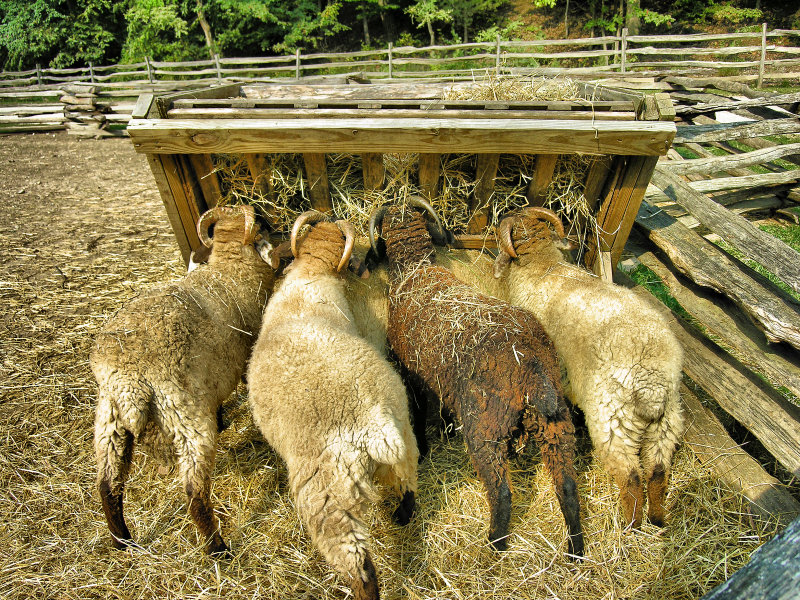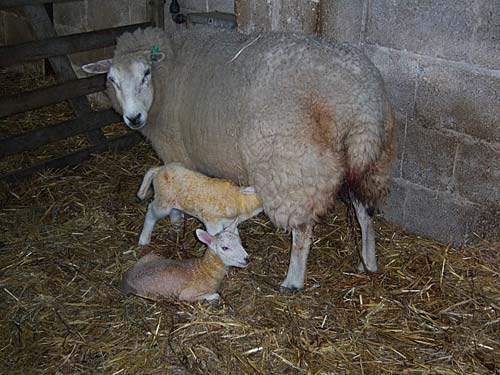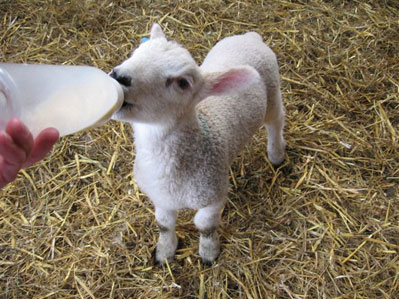SHEEP FEEDING
Sheep
Grazing – better thrive -on stubble after harvest
1. Highly resistant- water deprivation.
2. Bifid upper lip.
3. Consideration for fleece.
Flushing
Improving the nutritional status of ewes during 3-4 weeks prior to mating is known as ‘flushing’. Nutrition and body condition of the ewes prior to putting them to ram are important. Flushing will have effect only if the ewes were in declining phase of nutritional availability. Ewes in better body condition will produce more lambs and thus the flushing of leaner ewes will increase the fertility by way of increased incidence of oestrus and increased ovulation rate. To obtain increased lambing rate, the breeding ewes, 4-6 weeks prior to their being bred, should be supplemented with 250g of concentrate mixture or 500 g of good quality legume hay per head per day.

Sheep Feeding
Pregnant Ewes
The foetus makes two-thirds of its total growth during the last 6 weeks of pregnancy. The consequences of under-nutrition in late pregnancy are reduction in lamb’s birth weight, poor milk production and poor lamb survival. Under-nutrition may also result in occurrence of pregnancy toxaemia which results in collapse and possible death of the ewes. There is production of ketone and acetone bodies in the blood from the rapid breakdown of body fat to meet the energy requirements of advanced pregnancy. Thus, the amount of nutrients, especially energy, must be increased during the later part of pregnancy to ensure proper growth of foetus and high milk production.
Lactating Ewes
The requirements of energy and protein are higher during lactation. During early lactation sufficient quantity of good quality grazing and supplementary concentrate or legume hay or dry tree leaves should be provided as the demand for energy in lactation is very high. The lactation ewes require concentrate supplementation on even higher rate than the advanced pregnancy. Lactation also causes to mobilize body reserves of fat which is replaced with water. They should also be fed a high level of energy in early lactation.
A high protein diet improves the yield of milk but at the cost of the body reserves and hence both energy and protein should be balanced in the diet of lactation sheep.

Lactating Ewes
Lambs
A lamb should get sufficient amount of colostrums (first milk) from the mother during the first few days after birth. It imparts passive immunity, through gamma-globulins in which colostrums is very rich, against a number of infectious diseases against which the mother has been vaccinated or to which it has more recently been exposed to. There is no other way of protecting young lambs against these infectious diseases as they do not have their own immune system yet developed. Colostrum is also a rich source of energy and nourishes the newborn lamb, and acts as a laxative to clear the gut of the muconium. Colostrum is richer than milk in protein, vitamins A and D, cobalt, iron and lactose. If some lambs are orphaned and no ewes are available for fostering, it is necessary to rear them artificially. It will require some personal attention and training the lambs to suckle goats. Artificial feeding of milk using glass bottles with rubber nipples can be adopted, but hygienic measures must be adhered to. Lambs should be started on creep feed as soon as possible after birth. The consumption is negligible during first 2-3 weeks but will increase with age and weight. The creep ration (feed for young ones) should be highly palatable and rich in protein. Feeding of weaned lambs involves a balance between the use of cereals and the forages rich in energy and protein to achieve economic growth. The fattening lambs should fed special rations high in energy and protein and low in fibre. Lambs achieve satisfactory growth rate at a dry-matter intake level of 4 to 5 per cent of body weight

Feeding of Lamb
Fattening Lambs
The sheep meat available in the Indian markets comes either from old and culled sheep or from male lambs slaughtered any time between 6 months and 1 year of age. The quality and quantity of the meat produced from the male lambs is very poor due to poor market weight, low dressing percentage and narrow bone: meat ratio, since these lambs are maintained on scrub grazing like their dams. They hardly attain a body weight of 15-16 kg at the age of 8-9 months when they are usually marketed. The dressing percentage varies from 35 to 40 and bone: meat ratio from 1:4 to 1:4:25. Through crossbreeding of native sheep with exotic mutton breeds and extensive feeding of lambs marked improvement can be achieved both in live-weight gains and carcass quality.
FEED NUTRIENTS AND WATER REQUIREMENTS
The basic nutrients required by sheep are energy, protein, minerals and water.
Water
Water, though not considered a nutrient, is essential for proper functioning of the body as it is more vital for the maintenance of the animal life than any other feed component. It is the main constituent of all body tissues and helps in the excretion of waste products through faeces and urine. The body water plays and important role in the animal’s thermoregulatory mechanism. Most of the water requirement is usually satisfied by the water in the feed when green feed is available. Water intake in highly correlated with both air temperature and absolute humidity. Water requirement increases during growth, gestation, lactation and heat stress when salt content of the diet is more, or when animals are made to travel long distances. On dry feed, an adult sheep requires about 2 liters of water per day during winter and 3.5-4 litres during summer. Normally a sheep will drink approximately 2-3 litres of water for every 1 kg of dry, feed consumed. Sheep in desert areas can stand water deprivation up to 3 days. Watering free choice on alternative days has no deleterious effect. Sheep can tolerate salt content up to 1 per cent in the drinking water.
ENERGY
The soluble carbohydrates, fibre, fats and oils are the sources of energy. Such energy is used to produce heat to keep the body warm and to keep it cool through evapo-transpiration, and provide energy for physical activities and other life processes. The carbohydrates are also required for the growth and development of rumen micro-organisms. In their body weight both under stall feeding and grazing conditions. Lambs achieve satisfactory growth rate at a dry-matter intake level of 4 to 5 per cent of body weight. Different systems are in vogue all over the world to express the energy requirements. In India the digestible nutrients (TDN) system is in practice. In recent times metabolizable energy (ME) system is also being followed. The TDN requirement of lambs is higher than that of adult sheep. Similarly the pregnant, lactating and breeding ewes require more energy than the non-pregnant, non-lactating ones. As a thumb rule a non-pregnant, non-lactating ewe requires 10 g of TDN per kg live weight for maintenance and wool production. This requirement would be about 50 per cent more during last 6 weeks of pregnancy and 100 per cent more during the first 10 weeks of lactation. The energy deficiency may result in reproductive failure, poor growth and loss in body weight and may ultimately lead to death. The dry matter should contain about 50-55 per cent TDN for adults and 60-65 per cent TDN for growing lambs.
PROTEIN
Protein is the basic structural material of all the body tissues and is constantly required for the regeneration of all the living tissues which are undergoing constant wear and tear. The breeding animals need protein for prenatal growth, development of the foetus and to produce milk for post-natal growth of young ones. Clean soured wool or keratin is almost a pure protein. If the ration does not contain enough energy, the protein will be used as energy source. But protein cannot be replaced by any other nutrient in the ration. Protein deficiency causes reduced feed intake and poor feed efficiency. This would result in poor growth and development of muscle, reduced reproductive efficiency and wool production. The protein-deficient animals have lower disease resistance due to smaller amount of immune protein.
MINERALS
Minerals are required for the building and maintenance of the skeleton and teeth. They play an important role in digestion, in the maintenance of osmotic pressure in different body fluids and wool growth. Deficiency of any mineral will exhibit clinical symptoms. The role of the minerals in sheep nutrition is complicated. Excess of some of them may result in poor feed intake, digestion and utilization of other minerals, and can even cause toxicity. The common mineral deficiency symptoms are anorexia (reduced appetite), reduced gain or loss in body weight, unthriftiness, abnormal hair or wool coat and skin dullness, bone deformation, staggered gait and organ damage. Calcium and phosphorus are necessary for bone formation and its maintenance. Deficiencies or imbalance of these minerals are indicted by rickets in young ones and osteoporosis in adults. Deficiency of copper and cobalt may result in tetany and doggy wool. Selenium deficiency may lead to ‘white muscle’ disease in lambs. Sulphur is present in wool and hair and its deficiency will lead to poor wool production and quality. Inadequate supply of iron, copper and cobalt results in anaemia, and lack of iodine in goiter.
VITAMINS
Vitamins are metabolically essential. In sheep some vitamins are synthesized in their tissues and some by micro-organisms in their gastro-intestinal tract. The symptoms of vitamin deficiencies are anorexia, reduced growth, dermatitis, weakness and staggering gait. In sheep vitamin A is more important and its deficiency can cause various kinds of blindness. Vitamin deficiency also leads to abnormal bone development, weak and still-born lambs and respiratory problems.
(Source: Dr. Clemend, Central Farm. TNAU) |



